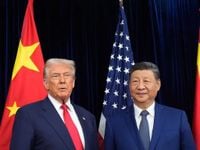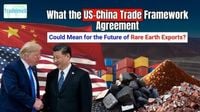In a move that has sent ripples through global markets and diplomatic circles alike, China announced on October 30, 2025, that it will pause a major expansion of its rare earth export controls for one year. The decision, revealed by China’s Ministry of Commerce, comes on the heels of a high-profile summit in Busan, South Korea, between U.S. President Donald Trump and Chinese President Xi Jinping. The two leaders, meeting face-to-face for the first time since 2019, agreed to a one-year trade truce that promises at least a temporary reprieve for industries and governments scrambling to adapt to a rapidly shifting landscape of tariffs, export bans, and geopolitical tension.
Rare earth elements—those metallic minerals essential for everything from smartphones and electric vehicles to advanced military hardware—have long been a strategic flashpoint in U.S.-China relations. China, which dominates the global supply of these critical materials, had announced on October 9, 2025, a fresh round of export controls that threatened to squeeze Western supply chains even further. But, as reported by RHJ and confirmed by China’s commerce ministry, those new restrictions will now be suspended for a year, easing immediate pressure on global buyers and sending rare earth stocks surging.
Yet, as with so many diplomatic breakthroughs, the devil is in the details—and in what’s left unsaid. According to The New York Times, while China has agreed to suspend its latest October controls, it has not rolled back earlier, more stringent export limits imposed in April and December. Those remain firmly in place, continuing to snarl supply chains and drive up prices. The April rules, for example, halted exports of seven kinds of rare earth metals and rare earth magnets—key components for everything from car brakes to fighter jets—unless buyers could secure special licenses from Beijing. The December controls targeted two metallic elements vital for semiconductors and two others used in military ammunition.
The impact has been dramatic. Factories in the U.S. and Europe, unable to secure enough rare earth magnets, have faced brief closures and inventory shortages. As Thomas Kruemmer, a rare earths consultant in Singapore, told The New York Times, the price of dysprosium—a heat-resistant metal used in automotive and defense systems—has skyrocketed outside China, jumping at least sixfold to an eye-watering $1,200 per kilogram. European Union and American business leaders have been vocal in their criticism, warning that the export controls are “putting the stability of global supply chains at stake.”
So why the sudden pause? Analysts suggest Beijing may have underestimated the global fallout from its October announcement. Kruemmer observed, “My impression is that they had no idea just how many products would be affected by this licensing system.” The Ministry of Commerce, for its part, has said it will “study and refine” the October 9 regulations, a move that suggests at least some willingness to address international concerns—even as it stops short of fully retreating from its broader strategy.
The rare earths reprieve was just one item on a packed agenda when Trump and Xi met in Busan. The summit, which lasted a brisk one hour and 40 minutes—much shorter than the four hours some had anticipated—produced a flurry of announcements. As reported by Al Jazeera, the two sides agreed to a “partial freeze” or “minor rollback” in their ongoing trade war. For the next year, China will delay export restrictions on five rare earth metals announced this month, but restrictions on seven others from earlier in the year will remain. Trump described the meeting as “amazing,” rating it “a 12 with 10 being best.”
The United States, in return, agreed to halve its 20 percent tariff on fentanyl-related products, reducing the overall tariff rate on Chinese goods from 57 percent to 47 percent. While some analysts, like Einar Tangen of the Taihe Institute in Beijing, dismissed the tariff cut as largely symbolic—“tariffs 30 percent or above mean that you effectively end trade”—the move was nonetheless welcomed as a step toward de-escalation. China, for its part, committed to “work very hard to stop the flow” of fentanyl, a synthetic opioid at the heart of America’s ongoing overdose crisis.
In another win for American agriculture, China agreed to immediately resume imports of U.S. soybeans, a crucial export for Midwest farmers and a political priority for the Trump administration. However, as The New York Times and Al Jazeera both noted, soybean futures in Chicago slipped after the summit, with traders expressing disappointment at the lack of concrete details about the scale and timing of new purchases.
Technology, too, was on the table—though not, perhaps, as front and center as some had hoped. Semiconductors, the building blocks of modern artificial intelligence and a major source of friction between Washington and Beijing, were discussed, but Trump clarified that “We’re not talking about the Blackwell,” referring to Nvidia’s latest AI processors, which remain under tight U.S. export controls. The question of Chinese access to U.S. technology, particularly in the fast-moving field of AI, remains unresolved.
Other elements of the truce include a one-year pause on Chinese countermeasures related to the U.S. Section 301 trade investigation, suspension of plans to extend technology-related export controls to Chinese subsidiaries, and a halt to tit-for-tat port fees. Trump announced plans to visit China in April 2026, with Xi expected to make a reciprocal visit to the U.S. “sometime after that.” Notably, the contentious issue of Taiwan did not come up during the talks.
For all the headline-grabbing announcements, many in the business community and among policy experts remain cautious. Sabrin Chowdhury, head of commodities at BMI (part of the Fitch Group), told The New York Times that it could take a decade for the U.S. and its allies to develop independent supply chains for rare earth materials. In the meantime, Western countries are investing heavily to reduce their reliance on China, but progress is slow and the risks of future disruptions remain high.
European officials, meanwhile, are seeking clarity on what China’s export pause will mean for them. The European Union Chamber of Commerce in China has warned that factories across the continent are struggling to secure enough rare earth magnets, and with only half of export license requests reportedly being approved by Beijing, uncertainty remains the order of the day. EU trade officials are set to meet with their Chinese counterparts in Brussels, hoping to hammer out more predictable arrangements.
As for the future, both sides have left the door open to further negotiations. Trump, for one, expressed optimism that the yearlong suspension of China’s October export controls will be extended before it expires. Xi, according to Chinese state media, emphasized that China “does not seek to challenge or replace any other country and instead focuses on doing its own business well.” He called for both sides to “focus on long-term benefits brought by cooperation rather than falling into a vicious cycle of retaliation.”
In the high-stakes world of U.S.-China relations, even a temporary truce offers a measure of relief—and a chance, however slim, for a more stable future. But with so many issues left unresolved and the underlying competition for technological and economic supremacy still simmering, few are betting that the calm will last.





